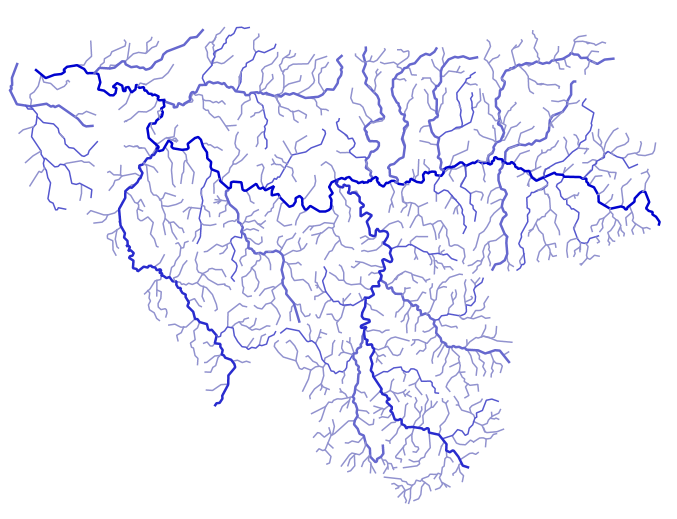2025
Type of resources
Available actions
Topics
INSPIRE themes
Keywords
Contact for the resource
Provided by
Years
Formats
Representation types
Update frequencies
status
Service types
Scale
-

Ce projet a pour ambition de mettre au point et d’appliquer une méthode non invasive de suivi des flux de poissons migrateurs dans la Sélune. Le développement de cette méthode repose sur l’analyse d’images et vidéos prises par une caméra hydroacoustique positionnée dans le cours d’eau.
-
Code and data to replicate the results in the paper Mating system and the evolution of recombination rates in seed plants. This publication is a meta-analysis gathering data on genetic maps and life history traits in more than one hundred plant species.
-
Collection de couches cartographiques d'occupation du sol de la Zone Atelier Armorique
-

Les macrophytes sont un ensemble de plantes aquatiques. Elles se situent à la base de la chaine alimentaire et peuvent fournir un habitat à de nombreuses autres espèces. L’abondance relative des différentes espèces permet de calculer un indice de qualité du milieu (IBMR). Dans le cadre de l'observatoire Sélune ont été disposées des stations pilotes le long du cours principal de la Sélune, réparties de l’amont à l’aval des barrages hydroélectriques. Trois stations se situent dans les anciennes retenues des barrages, les deux autres, dites de référence, sont hors zone d'influence des anciens barrages (l'une étant en aval et l'autre en amont). Dans ces stations, les biocénoses aquatiques (incluant macroinvertébrés benthiques, biofilms, macrophytes...) sont suivies. Les paramètres suivis sont la composition spécifique et le recouvrement, sur 8 stations du cours principal situées à l’amont, à l’aval et sur les zones néo-lotiques des communautés de macrophytes. La fréquence du suivi consiste en une campagne annuelle pour les stations hors retenues (S0, S1 et S5) et deux campagnes annuelles (printemps/automne) pour les stations néo-lotiques (S2, S3.4, S4.1 et S6). Le protocole mis en œuvre est le protocole d’échantillonnage des macrophytes et bryophytes suivant la norme NF T90-395 (octobre 2003) qui définit l’IBMR. Les taxa sont prélevés pour être identifiés en laboratoire. Cette couche donne la valeur de l'indice IBMR et EQR (normé) à une station pour une campagne ainsi que les informations concernant la robustesse de cet indice, les quantités de taxons utilisés pour le calcul de ces indices mais également des informations en terme de proportion de grands groupes floristiques (heterotrophes, algues, bryophytes, pteridophytes, helophytes, phanerogrames, végétation flottante et végétation immergée).
-

Les tronçons hydrographiques, constituants des cours d'eau, ont été extraits de la BD Topage sur l'emprise de la zone d'étude.
-

Les communautés microbiennes jouent un rôle majeur dans le fonctionnement des écosystèmes : elles sont à la base de la chaîne alimentaire (production primaire) et participent à la dégradation de la matière organique. Ces communautés sont, de plus, connues pour répondre rapidement à des changements environnementaux. Elles peuvent être utilisées comme indicateurs écologiques, à l'instar des macro-invertébrés. Les diatomées benthiques sont les organismes photosynthétiques majoritaires au sein de cette communauté biologique. L’abondance relative des différentes espèces permet de calculer un indice de qualité du milieu (IBD). Des fortes différences de communautés entre les zones amont et aval ont été constatés quand les barrages étant en place. Elles seront amenées à évoluer après l’effacement de ces barrages. Dans le cadre de l'observatoire Sélune ont été disposées des stations pilotes le long du cours principal de la Sélune, réparties de l’amont à l’aval des barrages hydroélectriques. Trois stations se situent dans les anciennes retenues des barrages, les deux autres, dites de référence, sont hors zone d'influence des anciens barrages (l'une étant en aval et l'autre en amont). Dans ces stations, les biocénoses aquatiques (incluant macroinvertébrés benthiques, biofilms, macrophytes...) sont suivies. Depuis septembre 2014, les stations sont idéalement échantillonnées tous les mois d’Avril à Octobre (7 relevés annuels) à l'aide de substrats artificiels (lames de verre disposées dans l'eau). En plus du relevé des diatomées (liste floristique, calcul de l'IBD), la concentration en chlorophylle-a est mesurée. Lors de chaque campagne, un protocole d'échantillonnage expérimental INRAe est mis en oeuvre. Ce protocole implique des dispositifs d'immersion (1 mois) de lames de verre, une mesure in situ de concentration en chlorophylle-a via BentoTorch puis une récolte du biofilm sur ces lames de verre. Le biofilm est conditionné dans (1) dans de l'éthanol à 99.9% pour la détermination des IBDs et des listes floristiques (prestation externalisée, s'appuyant sur la norme NF T90-354) et (2) dans de l'eau minérale pour mesure de concentration de la chlorophylle-a via spectromètre. La détermination des taxons s'appuie sur la version v17 de la référence TAXREF. Le jeu de données est actuellement sous embargo.
-

Ce projet dresse un état de référence, avec les barrages, des interactions trophiques entre les biocénoses aquatiques présentes sur la Sélune, allant des microorganismes aux poissons, dans les affluents et le fleuve lui-même de sa source à l’entrée dans l’estuaire.
-

Ce projet évalue l’impact de la restauration de la connectivité entre populations de poissons suite à l’effacement des barrages de la Sélune. Il se base sur le calcul d’un indice de fragmentation génétique sur 5 espèces de poissons.
-

Dans le cadre de l'observatoire Sélune ont été disposées des stations pilotes le long du cours principal de la Sélune, réparties de l’amont à l’aval des barrages hydroélectriques. Trois stations se situent dans les anciennes retenues des barrages, les deux autres, dites de référence, sont hors zone d'influence des anciens barrages (l'une étant en aval et l'autre en amont). Dans ces stations, les biocénoses aquatiques (incluant macroinvertébrés benthiques, biofilms, macrophytes...) sont suivies. Les paramètres suivis sont la composition spécifique et le recouvrement, sur 8 stations du cours principal situées à l’amont, à l’aval et sur les zones néo-lotiques des communautés de macrophytes. La fréquence du suivi consiste en une campagne annuelle pour les stations hors retenues (S0, S1 et S5) et deux campagnes annuelles (printemps/automne) pour les stations néo-lotiques (S2, S3.4, S4.1 et S6). Le protocole mis en œuvre est le protocole d’échantillonnage des macrophytes et bryophytes suivant la norme NF T90-395 (octobre 2003) qui définit l’IBMR. Les taxa sont prélevés pour être identifiés en laboratoire. Cette couche donne La détermination des taxons s'appuie sur la version v17 de la référence TAXREF. Le jeu de données est actuellement sous embargo.
-

L’ouverture des barrages va considérablement impacter le fonctionnement des populations de truites de la Sélune. Le rétablissement de la continuité écologique du fleuve modifiera les flux populationnels en autorisant la remontée plus en amont des truites de mer amphihalines et le déplacement des truites autochtones en aval et en amont des barrages. La population de truites est suivie sur un réseau de stations couvrant l’ensemble du bassin de la Sélune à l'aide d'un indice d’abondance, qui est effectué tous les 2 ans. Les campagnes de terrain respectent le protocole de pêche Vigitruite®, mis au point à l’INRAE et destiné à être utilisé partout en France. Cet indice d’abondance, rapporté à la superficie d’habitats favorables sur le cours d’eau permet d’évaluer la quantité de truitelles présentes dans la rivière, issues de la reproduction naturelle des années passées. Les campagnes de terrain sont assurées par INRAE et la Fédération d'Ille-et-Vilaine pour la Pêche et la Protection du Milieu Aquatique (FDAPPMA35) Cette couche donne les localisations de ces secteurs d'étude selon l'année d'étude : 2012, 2014, 2018, 2020, 2022 et 2024.
 OSURIS
OSURIS